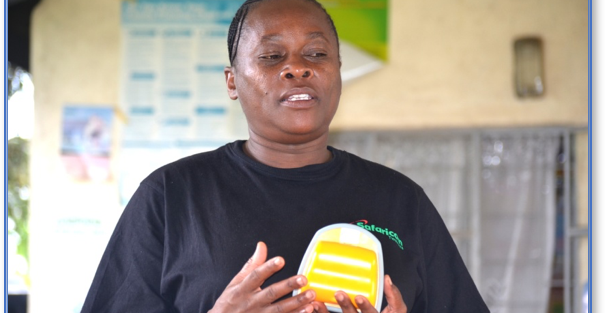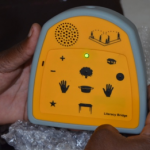When Doreen Oyiko Omukokwa, a Community Health Volunteer (CHV) leaves home every weekday morning, the most important thing she carries is a small talking book device called DigiSomo Talking Book.
It could be she is heading out to the Emuhaya Sub-County Hospital or to the field to talk with clients about anzilisha. Whatever the situation, the DigiSomo Talking Book is her faithful digital assistant. “I have been a Community Health Volunteer (CHV) for twelve years. In all that time I’ve acquired a good amount of knowledge. But I’m a human being who forgets,” Doreen says. “When this DigiSomo device came with anzilisha, it was like a saviour, a support for my faltering arms. It really is a God-send device.”

DigiSomo is a kind of a Talking Book which is a creation of Amplio Network and implemented by CBCC Africa. It contains all the information concerning anzilisha and is made to assist field workers deliver accurate information. Explains Doreen: “It lets me choose which message to play. I’m also able to record brief messages, in this case questions. The messages in DigiSomo Talking Book are for mothers and child health mostly. They are twenty-four in total and are normally played to a group sometimes at, but not limited to, the facility when pregnant and lactating mothers are present. To use it, I have to alert the mothers. I schedule the meeting with them in advance, so they can come early for the Health Talk, which comes before the MCH services and process begins.”
Health Talk is the time before treatment commences when patients are taught important issues about their health. It might involve talk about lifestyle adjustments to avoid certain possible illnesses, or what to do if those illnesses are already existent. It does not necessarily limit the topics to the reasons that have brought the clients to the facility in the first place. In Doreen’s case, she limits her topics to the health of mothers and children less than five years of age.
At the Emuhaya Sub-County Hospital facility where Doreen is working today, her audience consists of pregnant women, lactating mothers as well as those of 6-month old babies. “If they lend me their time, I can do up to three messages,” Doreen explains. “These would be messages to do with ANC, breastfeeding and starting complementary feeding. That way many mothers of different categories benefit.”
Doreen says the gadget is very important and has become a vital part of her work. It doesn’t fumble, is straight forward, simple, and is intuitive enough to simplify its use without a waste of time, she says. “Clients really benefit from it. Sometimes I might forget an important point. The gadget doesn’t. It has a button for volume and other actions and uses a battery of cells that can last about a month with heavy use.”

In fact, the gadget impresses and pleases the villagers. According to Doreen, the villagers feel that some ‘cool’ technology has come to be a part of their lives and they are proud to have such a gadget at work among them.
The anzilisha information came too late for Doreen who says she already stopped getting children. Nevertheless, she recognizes the absolute importance of the information encapsulated in the programme. “In my days I didn’t know about the 1000 days. I didn’t know a lot of things but anzilisha is helping me interpret and understand some of what I went through even then. If I had had access to this information, I’d have been a lot better off,” she says. “Now I know important points surrounding pregnancy, birth and care of children, which I share with new mothers.”
Doreen takes pride in being able to help new mothers do better than she did. “I’ve had this device since December 2017. I can’t remember exactly how many clients I’ve attended to. However, when you consider that on any given day I attend to anywhere between 20-25 clients, for five days a week and I’ve been doing this consistently since last December, a little calculation can give you an average number.”
Doreen is one of the many CHVs who are actively involved in anzilisha, a 5-year project (2016-2020) funded by Nutrition International whose objective is to reduce anaemia, low birth weight, maternal and new-born mortality as well as stunting. The project is implemented by Center for Behaviour Change and Communication in partnership with the Vihiga County Government and has had great benefits to mothers and their children in the region. Through this program 296 CHVs in 5 Counties have been trained and given the Talking Books to help them effectively deliver the anzilisha messages far and wide.

As much as Doreen’s humanity means she often needs DigiSomo Talking Book to remind her of what she needs to do, in the same way some mothers may forget or become reluctant to attend ANC. The nurse may not know how to get them but in liaison with Doreen, they are able to find them and try and bring them back. Besides, they have trained the women to note when they miss their menses. “Most of them now know that the moment they notice their period has delayed they walk straight into the facility to get help,” adds Doreen.
There are early indications that the labour of Doreen and other CHVs is bearing good fruit – exclusive breastfeeding has taken off tremendously and the children born the anzilisha-prescribed way are extremely healthy in comparison to those born the old-fashioned way. “The difference is amazingly clear,” she says. And a great deal of it is attributable to the accurate information provided through the DigiSomo gadget, of which she cannot stop talking effusively.
“DigiSomo Talking Book has had a great impact on my communication. It assists me. Where I may be wrong, it keeps me in line. I may not necessarily remember all the 24 messages. The gadget reminds me. Among the messages it contains are on attending ANC, getting IFAS, being aware of the danger signs in pregnancy, using CHX and the need to have the Mother-Child Health handbook.”

She says that though DigiSomo looks robust enough to probably withstand rough handling, she has never dropped hers; and she looks forward to many more years of improving the health of the community with her DigiSomo Talking Book assistant by her side.



